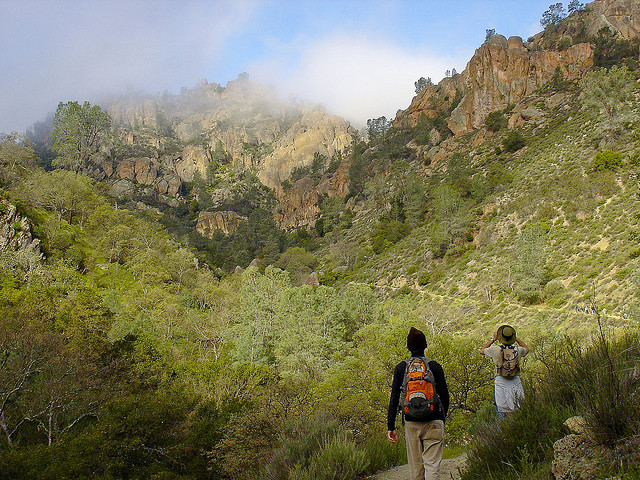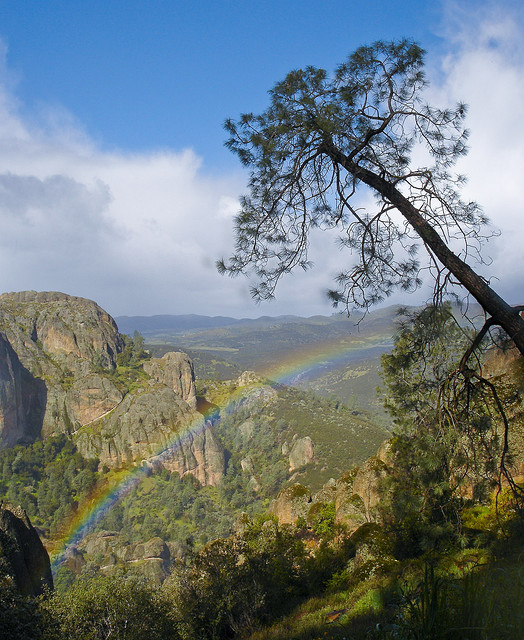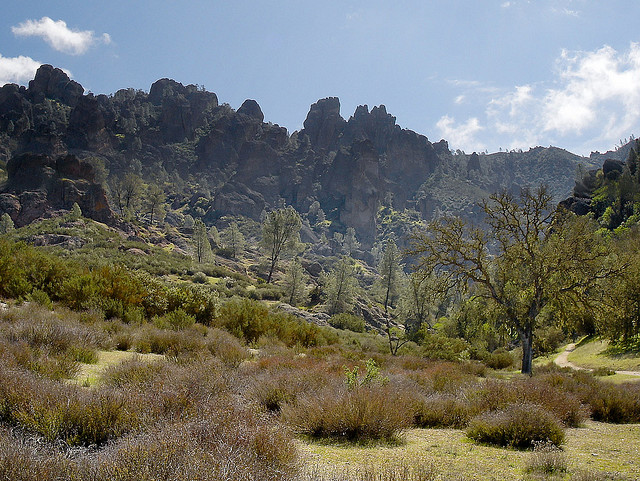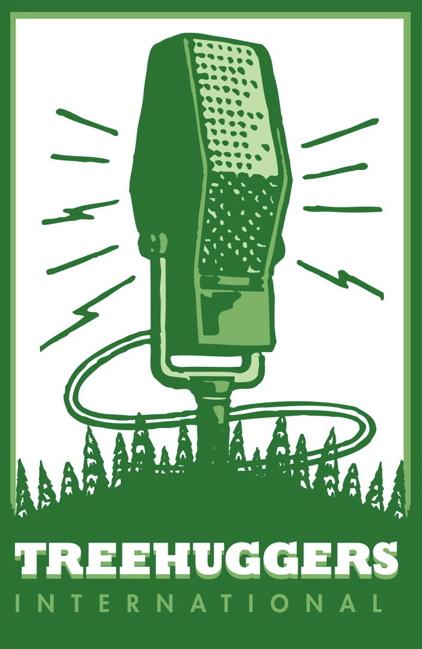Sen. Boxer Moves to Elevate Pinnacles National Monument to National Park Status
August 5th, 2010

Springtime along Condor Gulch Trail at Pinnacles National Monument.
The landscape of Central California is some of the most sublime in the nation, especially in early spring when the hills and valleys are equally green and lush with new grass and colorful poppies from winter rains. But as placid as the oak tree-dotted landscape is, it is also deceptive. Whether entering Pinnacles National Monument from the west side via the agricultural Salinas Valley, or the rugged, but no less idyllic east side, dominated by the nearby San Andreas Fault, nothing can prepare you for the outright primeval weirdness of the Pinnacles.
National Parks vs. National Monuments
First set aside as a National Monument by President Theodore Roosevelt in 1908, Pinnacles may see a promotion in status and become California’s first new National Park since Death Valley and Joshua Tree were given similar boosts in status from monuments to parks in 1994. While similarly managed by the National Park Service, the difference between parks and monuments isn’t necessarily in terms of management, but in how the units are set aside.
National Monuments are typically established by presidential decree under the 1906 Antiquities Act, and can be designated as such without Congressional approval if the natural character or qualities of the area may be threatened, or if the president feels Congress is moving too slow to declare the area a National Park.
While National Parks are generally afforded a higher level of protection and tend encompass whole ecosystems, the Antiquities Act stipulates “historic landmarks, historic and prehistoric structures, and other objects of historic or scientific interest” are suitable for consideration as National Monuments, but “shall be confined to the smallest area compatible with the proper care and management of the objects to be protected.” As a result National Monuments tend to be smaller than National Parks, but that hasn’t stopped presidents from creating monuments for varying criteria when the mood, political need, or desire may strike them.
Theodore Roosevelt went on a spree of creating numerous, yet modest-sized National Monuments in the early 1900s as an enthusiastic conservationist, including Devil’s Tower in Wyoming and Petrified Forest in Arizona (now also a National Park), but the Antiquities Act has also been used to set aside vast areas of federal land as protected areas, particularly by Jimmy Carter in 1978, when he set aside an extraordinary 15 areas in Alaska totaling nearly 80 million acres, almost all of which became National Parks two years later with the passage of the Alaska National Interest Lands Conservation Act.
Wild Landscape On the Move, Home to Condors
In conjunction with legislation introduced last year by Congressman Sam Farr of California’s 17th district, Senator Barbara Boxer has introduced a comparable Senate bill to make Pinnacles a National Park. According to the Salinas Californian, the bill
would change the site’s designation and add nearly 3,000 acres of the monument to the National Wilderness Preservation System.
The Californian adds
The 26,000-acre Monument [is] recognized for its ancient volcanic spires, colorful cliffs, numerous caves and diverse wildlife. It’s now a release site for the critically endangered California condor.
It’s fitting California condors call the prehistoric crags of the monument home. Pinnacles makes up the southernmost extension of the Galiban Mountains, a small, inland sub-range of the larger California Coastal Range, running along the border of Monterey and San Benito counties, and are remnants of the ancient Neenach Volcano, which last erupted some 23 million years ago. But the Pinnacles aren’t bizarre simply because of their volcanic origin, but because of where the volcano was located: 195 miles to the southeast, in the Mojave Desert near the present-day location of Edwards Air Force Base.

Rainbow along the Juniper Canyon Trail.
Over time, as the Pacific plate on the west side of the San Andreas Fault moved to the northwest relative to the North American plate, the Neenach formation, which erupted and grew on top of the San Andreas, was neatly bisected, with the western end carried off on an amazing journey which continues to this day.
The Pinnacles look nothing like the hills and and valleys surrounding it, and while the appearance and natural character of Central California has grown into a Mediterranean climate of chaparral, grasslands, and oak-woodland forests, the Pinnacles have retained their harsh, tortured, desert-like appearance, literal relics of another age and another climate deposited (for the moment) on the edge of the Salinas Valley.
The Pinnacles have also managed to retain their wild quality because of a wise decision against running a road through the length of the park. With U.S. 101 offering access to the west through Soledad, and State Route 25 offering access from the east along a dramatic route following the San Andreas Fault zone, the temptation certainly existed among area boosters and pre-war road builders to construct a “scenic” route through the monument. Now the decision against the road may be the monument’s strongest hand in consideration for full National Park status, as the area remains as it was when set aside in 1908. Much of the monument was also designated as wilderness in 1976.
Another component in the Monument’s wild quality are the features of the Pinnacles themselves, which have managed to avoid some head-on erosion processes by virtue of being located about 40 miles east of the coastal Santa Lucia range, which act as a rain shadow and keep the region slightly drier than the rest of Central California. As a result, the sharp volcanic rock features and prehistoric character of the monument persist into the 21st century. In an article on the condors of Pinnacles National Monument, author Tom Bentley wrote in the Los Angeles Times
[It is] an otherworldly place of jutting rock spires and twisted towers that looks as though it was wrenched from dinosaur times. ‘Wrenched’ is fitting: The park’s craggy upthrusts [are] a landscape in which a pterodactyl might choose to make its home.
We at Treehuggers International offer our thanks and support for Pinnacles’ proposed change in status to Senator Barbara Boxer and Representative Sam Farr, as well as David Edelson and our friends at the California/Nevada office of the Wilderness Society, along with the Wild Heritage Campaign and the California Wilderness Project.
Photos by kind permission of Miguel Vieira.

The High Peaks from the monument's Chaparral ranger station.
More about this post at:
- The Wilderness Society
- California Wild Heritage Campaign
- California Wilderness Project
- National Parks Conservation Association
- National Park Service, official Pinnacles National Monument page
- Sen. Barbara Boxer, press release regarding Pinnacles legislation
- Representative Sam Farr, proposal for Pinnacles National Park
- Push to Designate Pinnacles As Park (Monterey County Herald; 8/7/10)
- Pinnacles National Monument: California’s New National Park? (Los Angeles Times; 8/5/10)
- Bill Pushes for Pinnacles National Park (Salinas Californian; 8/5/10)
- Movement Afloat to Make Pinnacles National Monument Into National Park (LA’ist; 8/5/10)
- At Pinnacles Looking In On A Condor Nursery (Los Angeles Times; 4/25/10)
- Spring Road Trip to Pinnacles National Monument (Sunset; 4/1/10)
- Should Pinnacles Be Labeled A National Park? (National Parks Traveler; 8/2/09)
- Farr Introduces Pinnacles Bill (Hollister Freelancer; 7/31/09)





